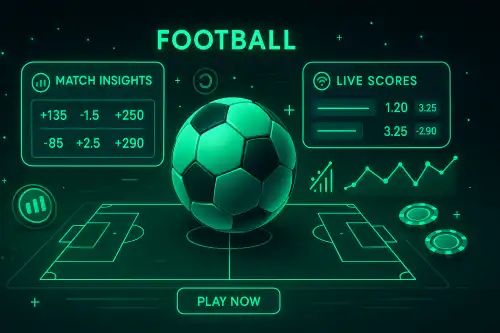A beginner-friendly guide to football betting at 3WE
Football is the world’s most watched sport—and one of the most exciting to bet on. This guide explains the key bet types, how odds work, and simple strategies so beginners can place smarter bets with confidence. Keep it fun and bet responsibly.

1) The core football markets
-
1X2 (Match Result)
Pick the Home win (1), Draw (X), or Away win (2) over 90 minutes plus stoppage time. It’s the simplest market and a great entry point. -
Asian Handicap (AH)
Levels the field by giving one team a head start (e.g., +0.5, +1.0) or a deficit (-0.5, -1.0).-
If you back Team A -0.5, they must win the match for your bet to win.
-
If you back Team B +0.5, your bet wins if Team B win or draw.
Quarter lines (e.g., -0.25, +0.75) split your stake across two nearby lines, reducing variance.
-
-
Over/Under (Totals)
Bet on the total goals scored by both teams (e.g., Over 2.5 means 3+ goals; Under 2.5 means 0–2 goals). -
Both Teams To Score (BTTS)
A simple yes/no bet on whether each team scores at least once. Great when both sides attack well but defenses leak chances. -
Double Chance
Covers two results (e.g., Home/Draw). Lower odds but higher hit rate—useful when you like a team not to lose. -
Draw No Bet (DNB)
Removes the draw as a losing outcome—if the match draws, your stake is refunded.
2) Live (in-play) football betting tips
In-play markets on 3WE update in real time. Watch momentum:
-
A team pressing hard and creating shots can make next team to score or Over live totals attractive.
-
If a favorite leads early and looks comfortable, Under or opponent +handicap can carry value if tempo slows.
3) How odds work
Most bettors use decimal odds (e.g., 1.80, 2.10). Potential return = stake × odds.
-
Example: Stake 100 at 2.00 returns 200 (100 profit).
-
Lower odds imply higher probability; higher odds imply lower probability but bigger payout.
4) Smart, simple strategy
-
Bankroll discipline:
Decide a fixed bankroll and use flat stakes (e.g., 1–2% per bet). Avoid chasing losses. -
Shop for value, not teams:
Don’t back a club “because you support them.” Compare form, injuries, schedule congestion, and styles (pressing vs. deep block). -
Pick your markets:
If you read defensive matchups well, Under/BTTS-No may suit you; if you spot mismatches, use Asian Handicaps. -
Limit parlays:
Accumulators boost payout but reduce win rate. If you play them, keep legs few and logical (e.g., correlated totals with team form).
5) Quick pre-match football checklist
-
Team news: Are key strikers/defenders missing?
-
Recent form & xG trends: Are they creating quality chances or living off low-quality shots?
-
Schedule & fatigue: Mid-week cups or travel matter.
-
Match context: Title race, relegation battle, or a dead rubber game affects intensity.
6) Worked example
-
Market: Asian Handicap
-
Fixture: Team A vs Team B
-
Pick: Team A -0.5 @ 1.95
-
Rationale: Team A at home, strong pressing, Team B missing starting CB.
-
Stake: 2% of bankroll.
-
Outcomes: Team A win → win bet; draw/lose → lose bet.
7) Common mistakes to avoid
-
Over-reacting to a single result—use at least 4–6 matches of data.
-
Ignoring price—a good team at bad odds is a bad bet.
-
All-in stakes—variance exists even with great reads.
-
Betting every game—specialize in a league or two.
8) Responsible betting at 3WE football
Set personal limits, track results, and take breaks. Football should be entertainment—never bet money you can’t afford to lose. If betting stops being fun, step back.
FAQs
Is 1X2 or Asian Handicap better for beginners?
Start with 1X2 to learn outcomes, then graduate to Asian Handicap for value and risk control.
What’s the safest market?
No market is “safe,” but Double Chance and DNB reduce downside.
Do I need stats to succeed?
You don’t need complex models, but basic data (shots, xG, injuries, schedule) improves your edge.
